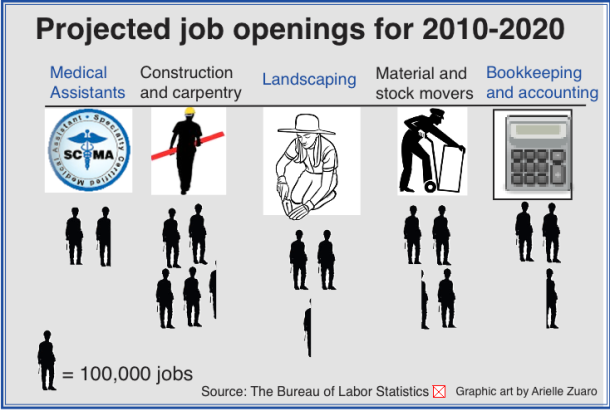staff editorial
The four-year college plan has become such an expectation that alternatives such as learning a trade and attending vocational schools often go unconsidered. Yet, in a country where the need for skilled laborers like welders, electricians, machinists, etc. is growing, education at two-year trade schools or vocational education programs needs to be promoted as options to pursue after high school.
It should be made clear to students that other forms of educational training have great value, as the demand for tradesmen such as construction workers, medical technicians, mechanics, and plumbers persists.
“[Tradesmen] have increased marketability, and their work, which must be done on premises, like bathroom remodeling, cannot be outsourced,” said guidance counselor Luke Kostu.
Skilled laborers are trained in specific areas, which makes them valuable in the job market. Many employers are unable to find those qualified workers to perform the jobs they need done.
In an article for The New York Times, Rich Motoko found that manufacturers are looking for workers who can operate advanced machinery and demonstrate proficiency in their field.
“Makers of innovative products like advanced medical devices and wind turbines are among those growing quickly and looking to hire,” said Motoko.
According to The Bureau of Labor Statistics, 25 percent of all new jobs will be in construction, retail trade and offices of health practitioners in the next seven years. In addition, construction is atop the list of the 20 jobs projected to have the largest salary and employment growth.
With state schools in New Jersey still costly, and private colleges and universities even more so, investing in vocational-skills programs may have worthwhile long-term benefits, such as the ability to work right out of high school in order to help fund further education in a certain field.
“Many students will begin with the trade skill and obtain business degrees after gaining a few years of experience or move on to entrepreneurial pursuits,” said Kostu.
At vocational schools, students are introduced to the specifics of what a job in their field could eventually look like.
“After this year I will be able to work as a medical assistant and use what I have learned in school,” said senior Dariana DeV`ore, who attends the Union County Academy for Allied Health part time in the morning.
Medical assistants draw blood and assist with taking vitals, administering medical tests and performing office duties. Most medical assistants’ starting salaries are determined by their previous schooling. Someone who took only a three-to-six-month class generally will start out with a lower salary than someone who earned a degree at an accredited college.
“I have learned many real- world skills at the Union County Vocational Technical School that I can use after I graduate high school,” said senior Liz Gelling, who is enrolled in the commercial arts program. “The program is run like an advertising agency. ‘Jobs’ come in regularly and once finished, each assignment is presented in a professional matter, in
adherence to how it would be in
the real world.”
If young workers continue to ignore skilled labor jobs and aren’t trained for them, there will be a deficit in the job market, which could affect the overall economy negatively. With the majority of the skilled work force approaching retirement, there is a lack of young people qualified to fill their spots.
If the economy continues its upward trajectory, and more college graduates find adequate work, the skilled labor gap will continue to grow in the future.
There is much opportunity for students who may not be considering a traditional college education, especially those who wish to master a skill or trade; a respectable art in itself that is in danger of being lost.
